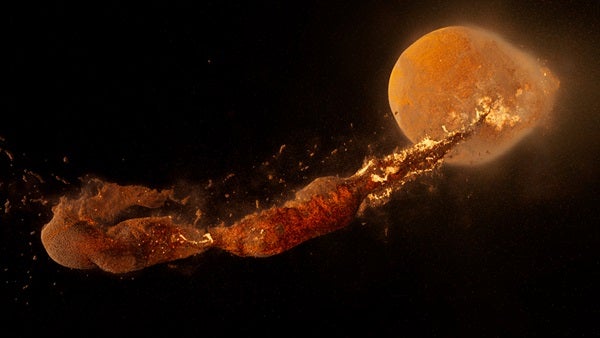The Moon is Earth’s constant companion. But as ubiquitous as Luna may seem, Earth hasn’t always had a moon.
Some 4.5 billion years ago, when the solar system was still forming, a wandering Mars-sized body named Theia slammed into a fledgling, moonless Earth. Traditionally, it is thought that this Theia-Earth collision spewed debris around our planet, which gradually coalesced to form the Moon. This theory for how the Moon formed is known as the Giant Impact Hypothesis.
But there are a few problems with the Giant Impact Hypothesis as it stands. The most glaring being the similarities between lunar rocks and Earth’s mantle. When the Apollo astronauts brought back samples from the Moon, scientists found that their isotopic signatures — chemical clues that point to where and how they were created — closely (but not perfectly) matched Earth. Thus, since no other body in the solar system so sharply resembles Earth’s rocks, it is likely that much of the material making up the Moon came from our planet.
But in the debris-disk scenario of the Giant Impact Hypothesis, it is material from Theia that constituted most of the debris that would eventually form the Moon. And alternative explanations often struggled to explain the Moon’s current orbit.
However, new simulations from scientists at Durham University’s Institute for Computational Cosmology point to a tweaked scenario in which the Moon formed immediately following the Theia collision. In fact, the simulations show the Moon might have formed in mere hours, which is far quicker than previously thought.
“This opens up a whole new range of possible starting places for the Moon’s evolution,” said lead author Jacob Kegerreis in a NASA press release. The paper was published Oct. 4 in the Astrophysical Journal Letters.
A puzzle of planetary proportions
The team modeled the Theia-Earth collision approximately 400 times, using smoothed particle hydrodynamics in their numerical simulations. This method, commonly deployed for simulations of giant impacts, enables scientists to model particles under the influence of both gravity and pressure. Previously, hundreds of thousands to millions of particles were used to simulate the formation of the Moon. But these new simulations utilized up to a hundred million particles, making them some of the most detailed yet.
The extra computational power showed that, at lower-resolutions, researchers miss out on crucial behaviors that occur in such collisions. “We went into this project not knowing exactly what the outcomes of these high-resolution simulations would be,” said Kegerreis. “So, on top of the big eye-opener that standard resolutions can give you misleading answers, it was extra exciting that the new results could include a tantalizingly Moon-like satellite in orbit.”
In their direct-formation simulations, the team was able to produce a Moon with a wide orbit and an interior that isn’t completely molten. Together, these attributes could help explain the Moon’s tilted orbit and relatively thin crust.
However intriguing, the simulations are still unable to explain everything we know about the Moon. Namely, the new simulations were able to form a Moon composed of 60 percent Earth material. But that still isn’t enough to explain the extreme isotopic similarities between Earth and the Moon.
“Even a clump with 60 percent protoEarth material, with the remainder from Theia, would still be expected to produce a much larger Earth-Moon isotopic difference than what we see,” Robin Canup, assistant vice president in the SwRI Space Science and Engineering Division, told Astronomy.
And while the paper suggests that material from both Theia and Earth may not have thoroughly mixed in the quickly forming Moon, creating a gradient of Earthlike material closer to the surface, Canup says that isn’t very likely. “For any portion of the Moon that forms intact, there is no opportunity for mixing between the protolunar and post-impact Earth material to remove such compositional differences.”
Looking forward
Determining the specifics of the Moon’s formation will require more analysis of lunar rocks plucked from unexplored regions of the Moon — something NASA’s upcoming Artemis missions hope to help with. Scientists are also looking to collect samples from beneath the Moon’s surface. Combined with simulations such as these, researchers are hopeful that they will be able to solve the mystery of exactly how the Moon formed around infant Earth some 4.5 billion years ago.
And, as a bonus, learning more about our celestial partner will also reveal more about Earth itself.
“The more we learn about how the Moon came to be, the more we discover about the evolution of our own Earth,” said Vincent Eke, a researcher at Durham University and a co-author of the new study. “Their histories are intertwined — and could be echoed in the stories of other planets changed by similar or very different collisions.”










